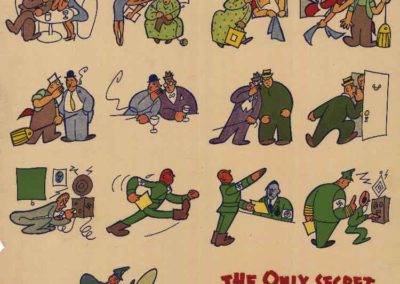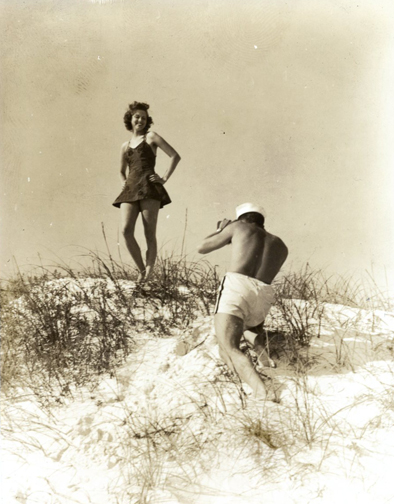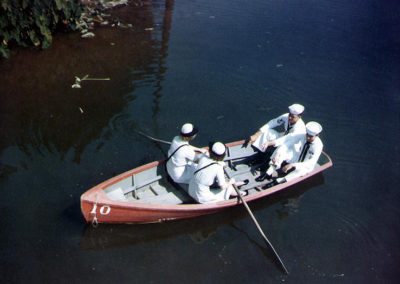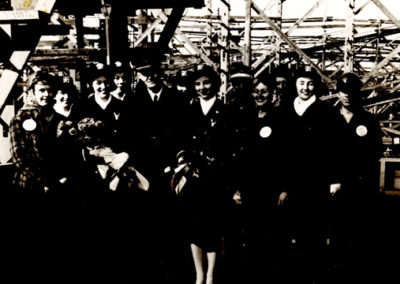Changing Attitudes
As the war progressed, the WAVES faced a number of challenges: rumors about their character, suspicions or resentment from military men and sometimes negative reactions from the community. But as the WAVES proved their mettle on the job, those attitudes would gradually change.
Changing Attitudes
Initial Reactions
As the WAVES moved from training to work, their presence at the bases caused reactions: from both within the Navy, as well as from the communities where they served.
Resistance
Military men often resisted, at least initially, women in the workforce. WAVE leader Mildred McAfee said some thought women couldn’t do the work:
This is the thing which I think was the most perplexing to a lot of people in the Navy, that this bunch of women came in here and, with no axe to grind at all, we just went on about our business. The men were perfectly astonished over the fact, for instance, that the first group of yeomen were good workers.
The male commanders appeared to have forgotten a key point. Office work was one area where young women of this era were able to find work as civilians. The women often learned stenography and accounting in high school or business college.
Men Shipping Out
Men, of course, sailors, were doing the [Link] training before. As soon as we came in, they were shipped out to sea. They weren’t too happy about it, because a lot of them had been in service before the war. You know, had been in the Navy. They had their families in Pensacola and they didn’t want to leave particularly. They liked the jobs they had.
– Janette Shaffer Alpaugh, World War II Navy WAVE
As Alpaugh explains, the resistance Navy men had about WAVES wasn’t just because they were suspicious women couldn’t do the work. Some also didn’t want to leave their comfortable shore jobs for the dangers and risks of the battlefront.
Making Due
But even in the face of resistance, the WAVES did their jobs. One group of WAVES at a Naval Air Station was told by the sailors there that they had to get some heavy equipment into the rafters of an airplane hangar. The sailors left, sniggering, knowing that the women didn’t have the strength to lift the equipment.
When they returned, they found the equipment in the rafters. The WAVES had rigged a pulley, and used it to leverage the equipment to its storage place.
“Their” WAVES Are OK
WAVES officers talk about how while men may have thought that women in the Navy in general was a bad idea, when asked about individual women they thought “their” WAVES were more than competent.
WAVES Leader Mildred McAfee recalled:
I found it awful hard to understand in those first months why the Navy men were so surprised that girls could do a good job, particularly in the office. Men would, as I’d go out and visit stations the chiefs, would come and say that we never dreamed that girls could do such good work.
Changing Attitudes
Outside Gossip
Outside of the Navy and Coast Guard, women were subject to rumor and innuendo. Some things were minor (perceived advantages WAVES and SPARs had) but others questioned the reputations of the women who served. Navy brass was well aware of the issue.
Resentment
I visited this one girl, woman that I knew real well. I go in the house. Her sister was in there. I didn’t know her sister. I had never met her sister. I was in uniform because you had to wear them all the time. And her sister said — “I want you to leave!” Just as soon as I stepped in the door. She wanted me to leave; I couldn’t imagine what was going on. And Teresa, this friend of mine, said to her, I don’t know her name, “What do you mean?” She said, “It’s because of her that my husband has to go out on a ship and any woman in uniform should not be in.” She said, “It’s the worst thing that ever happened to our country.” You see, from her point of view, that was how she thought. But I, I was astounded. I just said, “Oh, no, they need everybody.” I just said a few things then I turned around and left. There was no point in arguing or anything.
– Janettte Shaffer Alpaugh. World War II Navy WAVE
G. I. Nylons
The civilian women I worked with) saw my silk stockings. And they were envious because they said, “Oh, she’s got those GI nylons. That’s where she got those silks stockings.” You have to know silk was very rare. It came from Japan and Japan was our enemy. And so nylon wasn’t really hitting the markets yet. But it was beginning to. So even nylon stockings were hard to get. And so, I overheard this remark one day, “Oh, she’s got those GI nylons.” And so, I said, “Would you like a pair?” And their eyes were wide open and they said, “Well, yes.” They didn’t expect to hear anything like that from me. And so the next morning I brought them all a pair of the GI lisle, cotton lisle hose, that were thick and, you know, you couldn’t see through them at all, and they said, “Those aren’t nylons.” And I said, “Yes, they are. They are GI nylons. And we laughed and I said, “You know, I have to stand in line to get my nylon stockings just the same way that you do. And I have to go to Newberry’s and have the runs mended to make them last.”
– Virginia Gillmore, World War II Navy WAVE
“Loose Lips Sink Ships”
The popular poster and phrase was one way the OWI attempted to stop rumor-mongering during the war. It also set up a Division of Propaganda Research which interviewed Americans to find out what rumors were spreading in which part of the country. The OWI also launched appeals to people in magazines like Reader’s Digest, asking them to send in rumors they had heard.
Changing Attitudes
The Rumor Mill
Rumors ran rampant during wartime, so much so that the Office of War Information created a rumor project to understand what sort of rumors were spreading and where the rumors began. Women in the military were not immune to the rumors, which often focused on the sexuality of those who served.
I was in the Navy and the Navy and Army are different. So I don’t know when I really became aware. I certainly, for the people I did know in the Navy, as far as being what I would call quote unquote ‘loose women,’ I didn’t seem to be around it, that crowd, somehow. So I don’t know how it sorted itself out. That I was protected from them or what. I never worried about it.
Sailors who I encountered who had not had any relationships with the WAVES regarded them as prostitutes or something . . . One time my roommate and I were on a train to go to New York, I guess it was. Anyway, we encountered this sailor and he was practically telling us that. But he was a nice kid. We said, “Have you ever dated one? Do you know one?” Well, no. Well the following summer he got engaged to a girl, a WAVE, and we giggled about it to ourselves. But I think that, yes, they kind of resented us maybe, some of them.
The WAAC Whisper Campaign
Since the WAAC was the first group of women in the military, it seemed as if most of the rumors about military women focused on them. The rumors centered on the women’s sexuality; they were camp followers who had been issued condoms (i.e. prostitutes), playthings for men (i.e victims), or mannish (i.e. lesbians). And they got worse after the WAACs had been around for about a year.
The whispering campaign against the women’s corps gained momentum at the precise moment that the WAAC was trading its marginal status for full membership in the Army.
– Leisa Meyer, Creating G.I. Jane
“The Navy and the Army Are Different”
While the WAVES and SPARs interviewed admitted to hearing the rumors, they also tried to separate the WAVES from the WAACs reputation.
The women, WAACs, that was a bad name. They were pretty much considered like camp followers or that type of reputation. Not that they earned it, but that was the perception that people had of them. So WAACs were — oohh, you didn’t want to be involved with them.
– Barbara Stroda Wright, World War II Coast Guard SPAR
Turned Down!
We went to [rent an apartment] and the woman said, “I don’t have any vacancies.” Second one we went to the woman came out. “What do you want?!” “We are looking for an apartment for four girls.” She drew back like this. She said, “Well! Why don’t you ask those men who support you to rent you an apartment” “What are you talking about?” “Well,” she said, “why are you in the service other than to be available for the officers?” And you know you’re going like this, “What is she talking about?” She gave us [laughs] an education about what people thought about women in the service. This is shocking .. I had heard this vaguely about the Army. But WE were immune to that kind of stuff.
– Roberta Moore Hockett, World War II Coast Guard SPAR
Counteracting the Rumors
The OWI said rather than to deny the rumor, the organization should just issue “counteracting statement” to prove the rumor false. For the WAVES and SPARs, this method included focusing on the idea that by joining the Navy and Coast Guard, women would not lose their femininity, but would instead enhance it due to the Navy’s high standards and strict regimentation.
There was a kind of control over the girl in the Navy which she never had in a factory, for instance. If she was going to go into war work in a factory, she was really on her own, but there were standards of conduct and behavior which were watched for in he Navy and which she had clearly explained to her and expressed for her. I never had the feeling that a girl was going to be thrown with such bad characters that it was going to hurt her reputation, and I think this is really true that they weeded out the bad actors pretty quickly.
– Mildred McAfee, World War II Navy WAVE Commander
Changing Attitudes
Military Romance
Wartime, uncertainty about the future, young men and women serving together; it all offered the potential for romantic entanglements. At first, the Navy discouraged romances between sailors and WAVES. But as the war went on, and the WAVES proved their worth, that policy was reevaluated.
Official Policy
The initial Navy policy attempted to restrict the WAVES to unmarried women. A woman couldn’t enlist if she was married to a member of the Armed Forces (for a younger woman that would encompass virtually all of her male peers) nor could she marry during indoctrination or training periods. A WAVE could only be married to a civilian man.
Changing Rules
The first change to the marriage policy came quite quickly. In October of 1942, WAVES were allowed to marry men in any military service except the Navy. However, if a WAVE married a Naval man, she would be immediately discharged.
In March 1943, the policy changed again. Navy women could marry their male counterparts, but not during indoctrination or training. By August of the same year, the policy changed yet again, and women could marry during training, but only with permission of their commanding officers.
Fleeting Relationships
Blackie was my epitome of being a sailor. He loved his ship. He loved being a sailor and . . . he loved . . . he loved . . . in a sense he loved me . . . But, I found out that one day he was dating me and he wouldn’t do anything . . . but he would drop me off and go find the other kind of woman for the evening and stuff. He was scary but he was exciting.They say there is always first love and married love and baby love and the one you never forget . . . that’s Blackie.
– Josette Dermody Wingo, World War II Navy WAVE
“We Were Normal”
Despite the Navy’s attempts to protect the women’s reputation, the reality was that men and women did have romantic entanglements.
We were scared. We didn’t talk about it. It was only in night in bed when the lights went out that you wrapped yourself up and thought, “Oh my God. How’s this all going to end? Is it ever going to end?” We weren’t all the the time running around with the idea of getting a man or being in bed with a man or whatever. We were young and we were at the peak of our hormones and there was a damn war going on. There was a war going on. OK. We went to bed with guys. We made love. It felt good. It felt safe. It wasn’t something that we were running around getting money for or doing every day. We were in some people’s eyes promiscuous. In my eyes, we were normal.
– Helen Edgar Gilbert, World War II Navy WAVE
Changing Attitudes
Grudging Acceptance
The initial resentment from man in the military changed to acceptance as WAVES demonstrated their work was equal to – and sometimes better than – the work of men.
Changing Minds
“It was a man’s Navy,” said WAVE yeoman Margaret Gay. But from all accounts, the women were able to win over even the most reluctant male officer. WAVE Commander Mildred McAfee said even the officers who were opposed to WAVES in general felt “their” WAVES, women who they worked with directly, were fine. WAVE officers again and again told the story of a grumpy Navy captain who was assigned a female yeomen early in the war. He complained, but the woman wasn’t reassigned. At the end of the war, the naval officer was assigned another yeoman, this time a man. He again complained, but now he wanted to know why he wasn’t being assigned a WAVE.
“You Saved My Life!”
The acceptance was especially striking for Link Instructors. By the end of the war, EVERY Navy pilot had received at least some of his training from a WAVE. The Navy scuttlebutt went that the best pilots were those who had been trained entirely by WAVES.
We had to teach them what they call the square search. Where they were to fly in a direction for one minute and make a turn and fly, a left turn and fly in another direction until they could finally spot the field. If they were lost in the fog and didn’t know where they were and were coming down and didn’t see it. That was mainly extra protection to keep them from flying into a mountain. So, one day a young fellow came in and he grabbed me and gave me a big hug. He said, “You just saved my life.” The day before I had taught him the square search. He’d been out and had got (lost) in fog. He said, “It works! It works!”
– Jean Clark, World War II Navy WAVE
Official Praise
The WAVES) conduct, discharge of military responsibilities, and skillful work are in the highest tradition of the Naval Service.
– James Forrestal, Secretary of the Navy
The Navy has learned to appreciate the women… for their discipline, their skill and their contribution to high morale . . . Our greatest tribute to these women is the request for more WAVES.
– Ernest King, Navy Fleet Admiral
“Sure Smells Better”
Some of the men were very derogative, nasty, didn’t want us. We’re relieving them for active duty. Do you think they had open arms? No. You know, they swore and talked behind our backs and said nasty things to us. We had to just keep going on. We had to put one foot in front of the other, go to work, do the best we could. They finally began to see we were good at what we did. [One shift] we were on the mid-watch, sitting around talking about the pros and cons of women in the Navy. This one old Texan let us go on and on about the pros and cons and discussing it and all. Finally at the end of it, he was so cute, he sat back in his chair and said, “Well, I don’t know much about what y’all talking about, but I know one thing.” We said, “What’s that?” He said, “It sure smells better around here.” [laughs].
– Helen Edgar Gilbert, World War II Navy WAVE





